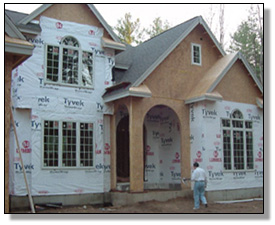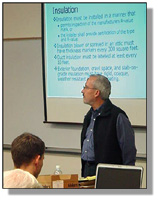Coming July 1, 2005...
Getting Ready for the New Nebraska Energy Code
The Nebraska Legislature adopted the 2003 International Energy Conservation Code as the Nebraska Energy Code effective July 1, 2005.
 The Legislature acted after aNebraska Energy Office study showed an updated code would generate dollar savings from reduced energy in excess of mortgage payment increases due to higher construction costs. Building energy use consumes 42 percent of overall energy use in Nebraska, and is higher than the national average of 34 percent. Studies have continually shown that improving the energy efficiency of new buildings can reduce energy use of those structures by 30–50 percent.
How will this affect Nebraskans? If you are building a new home or a commercial building after July 1, 2005, you will have to comply with the new statewide Nebraska Energy Code.
Local jurisdictions may adopt and enforce a lighting and thermal efficiency ordinance, resolution code or standard as long as it does not result in energy consumption greater than would result from the strict application of the Nebraska Energy Code.
Generally, building a new house to the updated code will save up to $125 a year in utility costs, depending on where the home is built. Savings will rise if the cost of energy rises.
Direct comparisons between the requirements of the 1983 Model Energy Code and the 2003 International Energy Conservation Code are complicated because of the significant changes in construction types, systems and products. In part, this is due to the new code allowing homeowners the option of “trading off” more efficient building options with less efficient options based on cost effectiveness. For example, installing a more energy efficient heating and cooling system will allow reduced efficiency requirements in other parts of the home such as less efficient windows or reduced insulation levels. The “trade off” allows the builder and homeowner to meet the minimum requirements of the code at the lowest cost.
The Legislature acted after aNebraska Energy Office study showed an updated code would generate dollar savings from reduced energy in excess of mortgage payment increases due to higher construction costs. Building energy use consumes 42 percent of overall energy use in Nebraska, and is higher than the national average of 34 percent. Studies have continually shown that improving the energy efficiency of new buildings can reduce energy use of those structures by 30–50 percent.
How will this affect Nebraskans? If you are building a new home or a commercial building after July 1, 2005, you will have to comply with the new statewide Nebraska Energy Code.
Local jurisdictions may adopt and enforce a lighting and thermal efficiency ordinance, resolution code or standard as long as it does not result in energy consumption greater than would result from the strict application of the Nebraska Energy Code.
Generally, building a new house to the updated code will save up to $125 a year in utility costs, depending on where the home is built. Savings will rise if the cost of energy rises.
Direct comparisons between the requirements of the 1983 Model Energy Code and the 2003 International Energy Conservation Code are complicated because of the significant changes in construction types, systems and products. In part, this is due to the new code allowing homeowners the option of “trading off” more efficient building options with less efficient options based on cost effectiveness. For example, installing a more energy efficient heating and cooling system will allow reduced efficiency requirements in other parts of the home such as less efficient windows or reduced insulation levels. The “trade off” allows the builder and homeowner to meet the minimum requirements of the code at the lowest cost.
 Another example is the difference where floors extend over unconditioned or outside areas. The 1983 Code required an insulation level of R-12.5 which included the insulating value of other building components. The new Nebraska Energy Code requires a level of R-21 for insulation only in this area.
More Workshops
To assist the state’s builders and codes officials, the Energy Office scheduled 19 workshops across the state. The first series of workshops on the new Nebraska Energy Code were completed in early December 2004, additionalworkshops for other groups — architects, engineers, builders and general contractors and heating, ventilating and air conditioning contractors — are scheduled for February, March and April 2005. Space remains available at most workshops. Early registration is recommended since seating is limited.
Another example is the difference where floors extend over unconditioned or outside areas. The 1983 Code required an insulation level of R-12.5 which included the insulating value of other building components. The new Nebraska Energy Code requires a level of R-21 for insulation only in this area.
More Workshops
To assist the state’s builders and codes officials, the Energy Office scheduled 19 workshops across the state. The first series of workshops on the new Nebraska Energy Code were completed in early December 2004, additionalworkshops for other groups — architects, engineers, builders and general contractors and heating, ventilating and air conditioning contractors — are scheduled for February, March and April 2005. Space remains available at most workshops. Early registration is recommended since seating is limited.
 Purchasing the Code
TheInternational Code Council is a nonprofit organization dedicated to developing a single set of comprehensive and coordinated national model construction codes. The founders of the ICC are Building Officials and Code Administrators International, Inc. (BOCA), International Conference of Building Officials (ICBO) and Southern Building Code Congress International, Inc. (SBCCI). The nation’s three model code groups created the International Code Council to develop codes without regional limitations.
Copies of the International Codes — the new Nebraska Energy Code — can be purchased from theInternational Code Council.
Federal Grant
The series of workshops on the new code has been made possible by a 2004 State Energy ProgramSpecial Projects grant to the Energy Office from the U.S. Department of Energy. The work under this grant is scheduled for completion by June 30, 2005.
Home
Energy
Loans
Energy Statistics
mailto:energy1%40mail%2estate%2ene%2eus">
Purchasing the Code
TheInternational Code Council is a nonprofit organization dedicated to developing a single set of comprehensive and coordinated national model construction codes. The founders of the ICC are Building Officials and Code Administrators International, Inc. (BOCA), International Conference of Building Officials (ICBO) and Southern Building Code Congress International, Inc. (SBCCI). The nation’s three model code groups created the International Code Council to develop codes without regional limitations.
Copies of the International Codes — the new Nebraska Energy Code — can be purchased from theInternational Code Council.
Federal Grant
The series of workshops on the new code has been made possible by a 2004 State Energy ProgramSpecial Projects grant to the Energy Office from the U.S. Department of Energy. The work under this grant is scheduled for completion by June 30, 2005.
Home
Energy
Loans
Energy Statistics
mailto:energy1%40mail%2estate%2ene%2eus">  State
of Nebraska Home
Disclaimer
State
of Nebraska Home
Disclaimer
 The Legislature acted after aNebraska Energy Office study showed an updated code would generate dollar savings from reduced energy in excess of mortgage payment increases due to higher construction costs. Building energy use consumes 42 percent of overall energy use in Nebraska, and is higher than the national average of 34 percent. Studies have continually shown that improving the energy efficiency of new buildings can reduce energy use of those structures by 30–50 percent.
How will this affect Nebraskans? If you are building a new home or a commercial building after July 1, 2005, you will have to comply with the new statewide Nebraska Energy Code.
Local jurisdictions may adopt and enforce a lighting and thermal efficiency ordinance, resolution code or standard as long as it does not result in energy consumption greater than would result from the strict application of the Nebraska Energy Code.
Generally, building a new house to the updated code will save up to $125 a year in utility costs, depending on where the home is built. Savings will rise if the cost of energy rises.
Direct comparisons between the requirements of the 1983 Model Energy Code and the 2003 International Energy Conservation Code are complicated because of the significant changes in construction types, systems and products. In part, this is due to the new code allowing homeowners the option of “trading off” more efficient building options with less efficient options based on cost effectiveness. For example, installing a more energy efficient heating and cooling system will allow reduced efficiency requirements in other parts of the home such as less efficient windows or reduced insulation levels. The “trade off” allows the builder and homeowner to meet the minimum requirements of the code at the lowest cost.
The Legislature acted after aNebraska Energy Office study showed an updated code would generate dollar savings from reduced energy in excess of mortgage payment increases due to higher construction costs. Building energy use consumes 42 percent of overall energy use in Nebraska, and is higher than the national average of 34 percent. Studies have continually shown that improving the energy efficiency of new buildings can reduce energy use of those structures by 30–50 percent.
How will this affect Nebraskans? If you are building a new home or a commercial building after July 1, 2005, you will have to comply with the new statewide Nebraska Energy Code.
Local jurisdictions may adopt and enforce a lighting and thermal efficiency ordinance, resolution code or standard as long as it does not result in energy consumption greater than would result from the strict application of the Nebraska Energy Code.
Generally, building a new house to the updated code will save up to $125 a year in utility costs, depending on where the home is built. Savings will rise if the cost of energy rises.
Direct comparisons between the requirements of the 1983 Model Energy Code and the 2003 International Energy Conservation Code are complicated because of the significant changes in construction types, systems and products. In part, this is due to the new code allowing homeowners the option of “trading off” more efficient building options with less efficient options based on cost effectiveness. For example, installing a more energy efficient heating and cooling system will allow reduced efficiency requirements in other parts of the home such as less efficient windows or reduced insulation levels. The “trade off” allows the builder and homeowner to meet the minimum requirements of the code at the lowest cost.
 Another example is the difference where floors extend over unconditioned or outside areas. The 1983 Code required an insulation level of R-12.5 which included the insulating value of other building components. The new Nebraska Energy Code requires a level of R-21 for insulation only in this area.
More Workshops
To assist the state’s builders and codes officials, the Energy Office scheduled 19 workshops across the state. The first series of workshops on the new Nebraska Energy Code were completed in early December 2004, additionalworkshops for other groups — architects, engineers, builders and general contractors and heating, ventilating and air conditioning contractors — are scheduled for February, March and April 2005. Space remains available at most workshops. Early registration is recommended since seating is limited.
Another example is the difference where floors extend over unconditioned or outside areas. The 1983 Code required an insulation level of R-12.5 which included the insulating value of other building components. The new Nebraska Energy Code requires a level of R-21 for insulation only in this area.
More Workshops
To assist the state’s builders and codes officials, the Energy Office scheduled 19 workshops across the state. The first series of workshops on the new Nebraska Energy Code were completed in early December 2004, additionalworkshops for other groups — architects, engineers, builders and general contractors and heating, ventilating and air conditioning contractors — are scheduled for February, March and April 2005. Space remains available at most workshops. Early registration is recommended since seating is limited.
 Purchasing the Code
TheInternational Code Council is a nonprofit organization dedicated to developing a single set of comprehensive and coordinated national model construction codes. The founders of the ICC are Building Officials and Code Administrators International, Inc. (BOCA), International Conference of Building Officials (ICBO) and Southern Building Code Congress International, Inc. (SBCCI). The nation’s three model code groups created the International Code Council to develop codes without regional limitations.
Copies of the International Codes — the new Nebraska Energy Code — can be purchased from theInternational Code Council.
Federal Grant
The series of workshops on the new code has been made possible by a 2004 State Energy ProgramSpecial Projects grant to the Energy Office from the U.S. Department of Energy. The work under this grant is scheduled for completion by June 30, 2005.
Home
Energy
Loans
Energy Statistics
mailto:energy1%40mail%2estate%2ene%2eus">
Purchasing the Code
TheInternational Code Council is a nonprofit organization dedicated to developing a single set of comprehensive and coordinated national model construction codes. The founders of the ICC are Building Officials and Code Administrators International, Inc. (BOCA), International Conference of Building Officials (ICBO) and Southern Building Code Congress International, Inc. (SBCCI). The nation’s three model code groups created the International Code Council to develop codes without regional limitations.
Copies of the International Codes — the new Nebraska Energy Code — can be purchased from theInternational Code Council.
Federal Grant
The series of workshops on the new code has been made possible by a 2004 State Energy ProgramSpecial Projects grant to the Energy Office from the U.S. Department of Energy. The work under this grant is scheduled for completion by June 30, 2005.
Home
Energy
Loans
Energy Statistics
mailto:energy1%40mail%2estate%2ene%2eus">